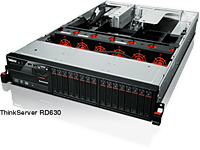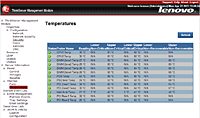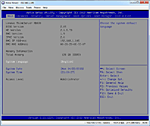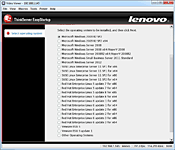Choosing server hardware in today’s market is often based more on vendor preference than on pure cost or performance. Many companies have long-standing agreements with one particular server vendor and probably won’t be changing any time soon.
Still, for anyone looking to make a new purchase, fortunately there are plenty of choices out there. The approach we recommend is to define your operating requirements and then choose the system that best meets your needs for the lowest cost.
The lowest purchase cost isn’t always the best in the long run, though. There are many of other considerations, not the least of which is ongoing management and maintenance.
It does make sense to stay with a single vendor to take advantage of consistent management tools. If your vendor of choice happens to be Lenovo, you’ll want to make sure you have the latest and greatest versions of their management tools at your disposal.
That brings us to our server review of the month, the Lenovo ThinkServer RD630.  The ThinkServer RD630 offers a great platform upon which a system can be configured to meet a wide range of applications.
The ThinkServer RD630 offers a great platform upon which a system can be configured to meet a wide range of applications.
Hardware Features
The RD630 boasts a high degree of flexibility for a 2U server. With room for up to sixteen small form-factor disks, you can build a storage server with up to 16TB using SATA drives, or 14.4TB of fast SAS drives.
The twenty DIMM slots make it possible to load the system up with 320GB of memory. Couple that with dual-socket Intel Xeon E5-2600 CPUs, and you have high-end horsepower in a small package.
Our system as tested came with 128 GB of memory, six Toshiba 600GB 10K SAS disk drives, dual Intel E5-2690 CPUs and dual redundant power supplies. The current suggested retail price for the system as configured is right around $13,000.
While our RD630 test system also came with a standard dual-port Gigabit Ethernet adapter, Lenovo also offers a quad-port Gigabit adapter as well as a dual-port Intel X520-T2 10-Gigabit Ethernet adapter.
Six fans span the entire width of the inside of the case to provide airflow from front to rear across the electronic components. Popping the lid on the RD630 reveals a well-designed interior with easy access to all user-serviceable parts like the memory.
There’s room for up to five PCIe GEN3 boards to meet your I/O needs and a wide variety of device options. Our unit did have one of the PCIe slots taken by the SAS disk controller. Ample use of instrumentation for monitoring power and temperature are scattered throughout the box and can be viewed through the software management tools.
 Management Tools
Management Tools
For remote, out-of-band management there is the ThinkServer Remote Management Module. This tool provides features like USB 2.0 media redirection, KVM over IP, and full remote power management.
Figure 1 shows a screenshot of the Temperatures screen from the Web-based interface. The KVM capability is Java-based and launches from the Web-based management tool. Once you launch the tool you have full control of the console of the RD630 just as if you were sitting in front of the machine. Figure 2 shows a screen capture of the BIOS screen viewed from the KVM tool.
 Lenovo offers a freely downloadable tool for initial configuration of new servers called the ThinkServer EasyStartup program. The latest available version is 3.7.12, and it’s a hefty 3.1 GB download from the Lenovo support site.
Lenovo offers a freely downloadable tool for initial configuration of new servers called the ThinkServer EasyStartup program. The latest available version is 3.7.12, and it’s a hefty 3.1 GB download from the Lenovo support site.
One of the options with the OS installation tool is to save your answers to an XML file on a USB drive for later reuse. This can come in handy when configuring multiple servers. Be aware though that the username and password are saved in clear text in the XML file, so take appropriate cautions.
Operating system installation support includes Windows Server 2003, 2008, 2012, VMware ESXi 5.0, 5.1, SUSE Linux Enterprise Server 11 and multiple versions of Red Hat Linux (see Figure 3).
 Lenovo also offers their ThinkServer EasyManage tool, which is a Windows program for performing much of the same functions that can be accomplished using the Web interface. It communicates with the server using an Intelligent Platform Management Interface (IPMI).
Lenovo also offers their ThinkServer EasyManage tool, which is a Windows program for performing much of the same functions that can be accomplished using the Web interface. It communicates with the server using an Intelligent Platform Management Interface (IPMI).
The plug-in monitor allows the program to communicate with the server hardware by accessing the Baseboard Management Controller (BMC). Figure 4 demonstrates using the Virtual Media Session dialog to map a fixed image of a device, such as an .iso installation file, to one of the remote devices.
Bottom Line
 The Lenovo RD630 is a solid performer with flexible features and useful software management tools. It’s definitely a platform you could build your data center computing needs upon or set up to service a small or remote office.
The Lenovo RD630 is a solid performer with flexible features and useful software management tools. It’s definitely a platform you could build your data center computing needs upon or set up to service a small or remote office.
With the high number of disk slots you could even build a storage server for providing reliable storage at reasonable cost. Whatever task you want to throw at the RD630, it’s more than up to the job.
Paul Ferrill, based in Chelsea, Alabama, has been writing about computers and software for almost 20 years. He has programmed in more languages than he cares to count, but now leans toward Visual Basic and C#.

